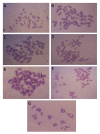Effects of Perivitelline Fluid Obtained from Horseshoe Crab on The Proliferation and Genotoxicity of Dental Pulp Stem Cells
- PMID: 26199904
- PMCID: PMC4503839
- DOI: 10.22074/cellj.2016.3726
Effects of Perivitelline Fluid Obtained from Horseshoe Crab on The Proliferation and Genotoxicity of Dental Pulp Stem Cells
Abstract
Objective: Perivitelline fluid (PVF) of the horseshoe crab embryo has been reported to possess an important role during embryogenesis by promoting cell proliferation. This study aims to evaluate the effect of PVF on the proliferation, chromosome aberration (CA) and mutagenicity of the dental pulp stem cells (DPSCs).
Materials and methods: This is an in vitro experimental study. PVF samples were collected from horseshoe crabs from beaches in Malaysia and the crude extract was prepared. DPSCs were treated with different concentrations of PVF crude extract in an 3-(4,5-dimethylthiazol-2-yl)-2,5-diphenyl tetrazolium bromide (MTT) assay (cytotoxicity test). We choose two inhibitory concentrations (IC50 and IC25) and two PVF concentrations which produced more cell viability compared to a negative control (100%) for further tests. Quantitative analysis of the proliferation activity of PVF was studied using the AlamarBlue®assay for 10 days. Population doubling times (PDTs) of the treatment groups were calculated from this assay. Genotoxicity was evaluated based on the CA and Ames tests. Statistical analysis was carried out using independent t test to calculate significant differences in the PDT and mitotic indices in the CA test between the treatment and negative control groups. Significant differences in the data were P<0.05.
Results: A total of four PVF concentrations retrieved from the MTT assay were 26.887 mg/ml (IC50), 14.093 mg/ml (IC25), 0.278 mg/ml (102% cell viability) and 0.019 mg/ml (102.5% cell viability). According to the AlamarBlue®assay, these PVF groups produced comparable proliferation activities compared to the negative (untreated) control. PDTs between PVF groups and the negative control were insignificantly different (P>0.05). No significant aberrations in chromosomes were observed in the PVF groups and the Ames test on the PVF showed the absence of significant positive results.
Conclusion: PVF from horseshoe crabs produced insignificant proliferative activity on treated DPSCs. The PVF was non-genotoxic based on the CA and Ames tests.
Keywords: Genotoxicity; Horseshoe Crabs; Mutagenicity; Proliferation.
Figures




Similar articles
-
Enhancement of angiogenesis by a 27 kDa lectin from perivitelline fluid of horseshoe crab embryos through upregulation of VEGF and its receptor.J Nat Prod. 2013 Jan 25;76(1):117-20. doi: 10.1021/np3005198. Epub 2013 Jan 14. J Nat Prod. 2013. PMID: 23316979
-
Genotoxicity evaluation of dental restoration nanocomposite using comet assay and chromosome aberration test.Nanotechnology. 2013 Jan 11;24(1):015105. doi: 10.1088/0957-4484/24/1/015105. Epub 2012 Dec 7. Nanotechnology. 2013. PMID: 23221152
-
Tobacco dust induced genotoxicity as an occupational hazard in workers of bidi making cottage industry of central India.Toxicol Int. 2014 Jan;21(1):18-23. doi: 10.4103/0971-6580.128785. Toxicol Int. 2014. PMID: 24748730 Free PMC article.
-
The comet assay with multiple mouse organs: comparison of comet assay results and carcinogenicity with 208 chemicals selected from the IARC monographs and U.S. NTP Carcinogenicity Database.Crit Rev Toxicol. 2000 Nov;30(6):629-799. doi: 10.1080/10408440008951123. Crit Rev Toxicol. 2000. PMID: 11145306 Review.
-
Analysis of published data for top concentration considerations in mammalian cell genotoxicity testing.Mutagenesis. 2010 Nov;25(6):531-8. doi: 10.1093/mutage/geq046. Epub 2010 Aug 18. Mutagenesis. 2010. PMID: 20720196 Review.
References
-
- Shuster CN Jr. A pictorial review of the natural history and ecology of the horseshoe crab, Limulus polyphemus, with reference to other limulidae. Prog Clin Biol Res. 1982;81:1–52. - PubMed
-
- Botton ML, Ropes JW. Populations of horseshoe crabs, Limulus polyphemus, on the northwestern Atlantic continental shelf. Fish Bull. 1987;85(4):805–812.
-
- Chatterji A, Abidi SAHJ. The Indian horseshoe crab: a living fossil. J Indian Ocean Stud. 1993;1:43–48.
-
- Chou LM, Tan KS. Corals, worms and molluscs. In: Davidson GWH, Ng PKL, Ho HC, editors. The Singapore red data book: threatened plants and animals of Singapore. 2nd ed. Singapore: The Nature Society (Singapore); 2008. pp. 39–61.
-
- Shin P, Li HY, Cheung SG. Horseshoe crabs in Hong Kong: current population status and human exploitation. In: Tanacredi JT, Botton ML, Smith DR, Earle SA, editors. Biology and conservation of horseshoe crabs. Heidelberg: Springer Science and Business Media; 2009. pp. 347–360.
LinkOut - more resources
Full Text Sources
